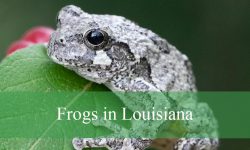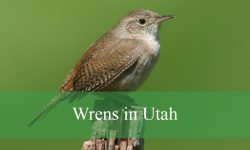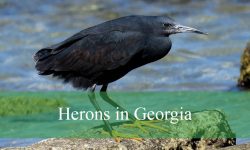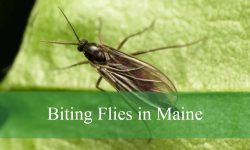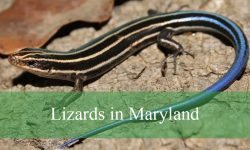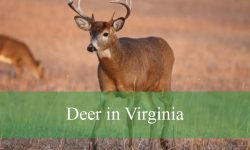Brown birds in Florida include various species, such as the Bewick’s Wren and Spotted Towhee. Bewick’s Wrens are accidental visitors, last seen in 2013, with brown backs, long gray tails, and a white stripe over the eye. Spotted Towhees, occasionally spotted during migration, have brown females and black-and-brown males with white spots. Both species highlight the diversity of brown birds in Florida’s bird-watching scene.
Continue reading the article below to learn more about approximately 45 species of brown birds, with their characteristics and identification features, that can be found in Florida.
Different Types of Brown Birds in Florida
Eastern Phoebe
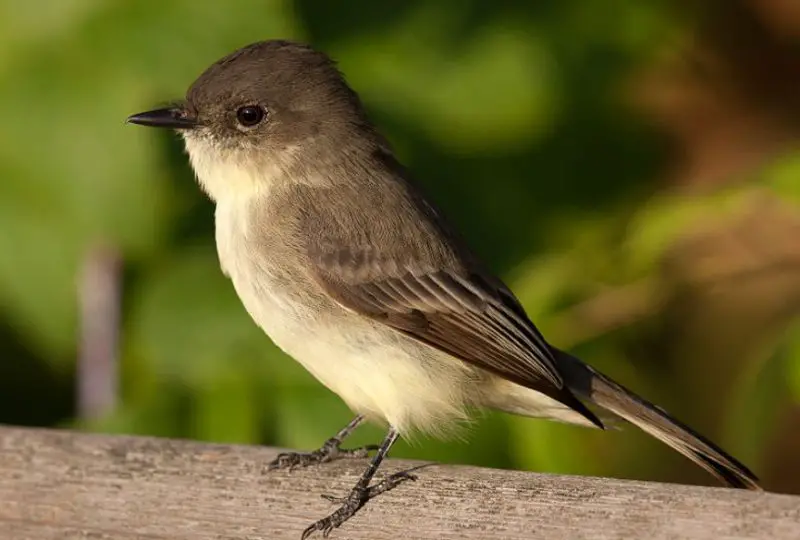
Eastern Phoebes, winter residents in Florida from October to March, are identifiable by their plump stature and coloration: grayish-brown on the back and whitish underneath, with a darker head. These migratory birds breed in northeastern and central US states, extending into Canada, before migrating south for winter, though some remain year-round in southern regions.
Typically solitary, they perch low in quiet woodlands, often wagging their tails while foraging for flying insects, supplemented by spiders, fruit, and seeds. They construct nests of mud and grass on structures like bridges or houses and can be attracted to backyard environments with nest boxes or berry-producing native plants.
Common Yellowthroat
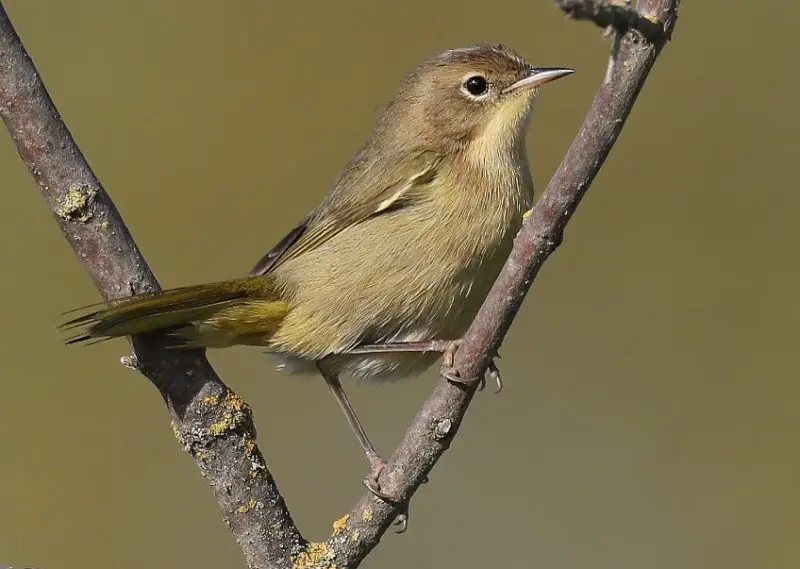
Common Yellowthroats are small songbirds found year-round in Florida, recognized by their brownish backs and bright yellow undersides, with males sporting distinctive black masks across their faces. Their yellow plumage varies geographically, sometimes appearing more olive-toned underneath.
Breeding across much of North America during summer, except Alaska and northern Canada, they migrate south for winter, with some remaining along the Gulf Coast and Pacific Southwest. Found in marshes, wetlands, and brushy fields with thick vegetation, they are attracted to large backyards with native plants that support insect populations.
Great-crested Flycatcher
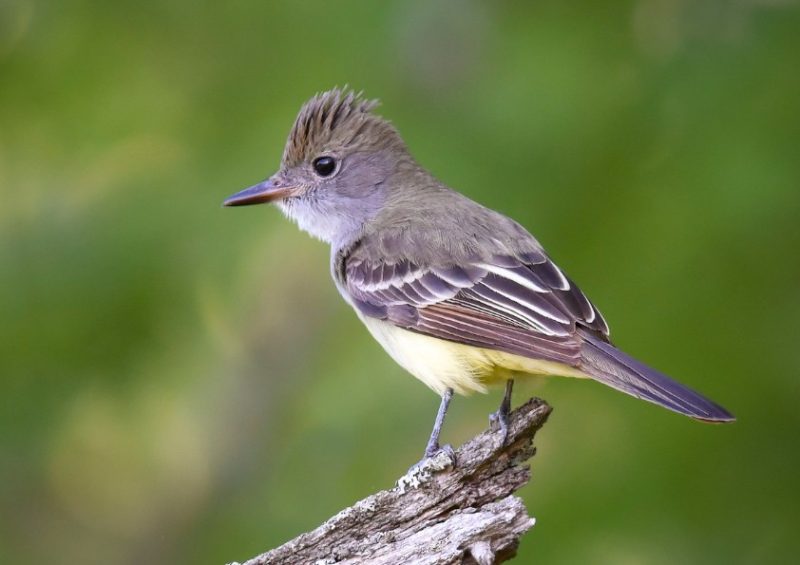
Great Crested Flycatchers, observed mainly during breeding season from March to September in Florida but also present year-round, are identified by their brown backs, yellow bellies, and gray throats. They display reddish flashes in their wing and tail feathers, with a crest that is subtly noticeable. These birds breed across much of eastern North America and winter in southern Florida, southern Mexico, and Central America.
They perch high in woodlands, preying on large flying insects like butterflies, grasshoppers, and moths, often found in mixed woodlands, clearings, and parks. Attract them to your backyard with native plants for insects and berry-producing species, along with nest boxes for nesting opportunities.
Brown Thrasher
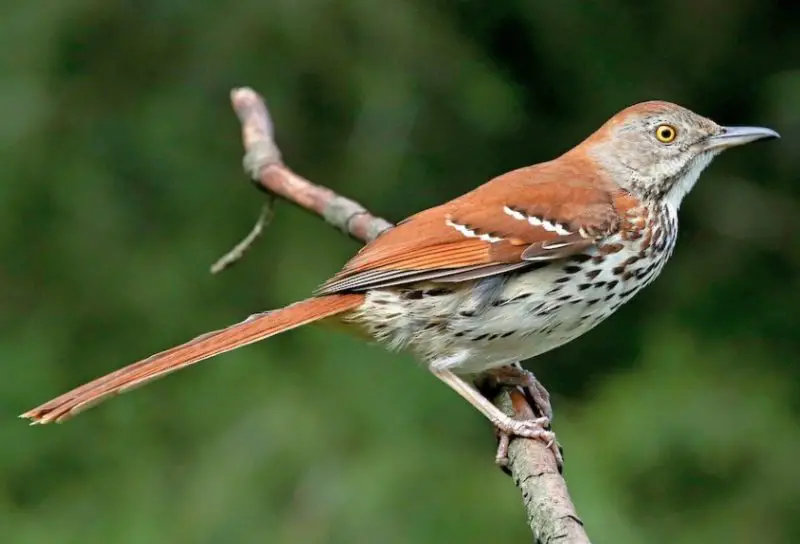
Brown Thrashers, year-round residents in Florida, resemble robins in size but boast distinctive features: brown backs, white-streaked chests, gray faces, and bright yellow eyes. They inhabit central and eastern North America, with southeastern populations staying year-round while northern birds migrate south for winter.
They prefer thickets and shrubs, where they forage for insects in leaf litter and soil. Known for their extensive repertoire, they sing over 1000 song types, making them among the most accomplished North American songbirds. Attract them with dense cover, berry shrubs, and scattered seeds in your backyard.
Eastern Towhee
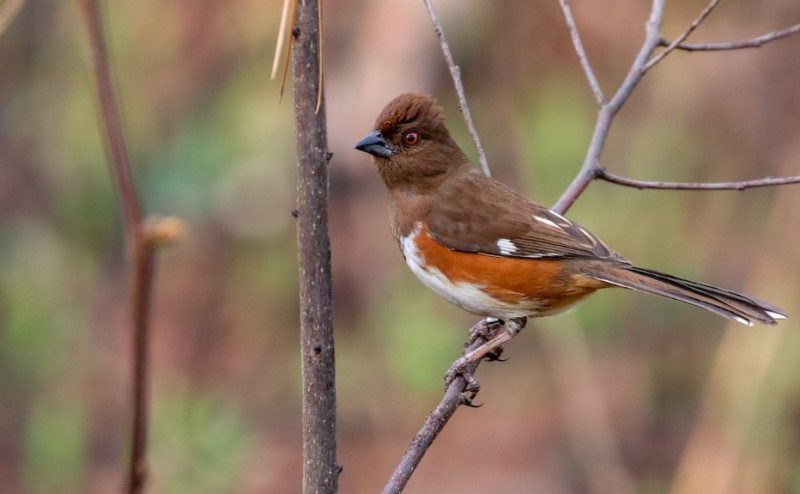
Eastern Towhees are year-round residents in Florida, noted in 9% of summer and 5% of winter bird checklists. These large sparrows, akin in size to robins, feature striking black heads, throats, and backs, with reddish sides and white bellies in males; females are brown instead of black. They inhabit southeastern US states year-round, with northern populations migrating south for winter.
Often found foraging in undergrowth and forest edges, they nest on the ground amidst leaves, crafting nests from twigs, bark, and grass. Attract them to your backyard with dense borders and varied seeds in platform feeders.
House Wren
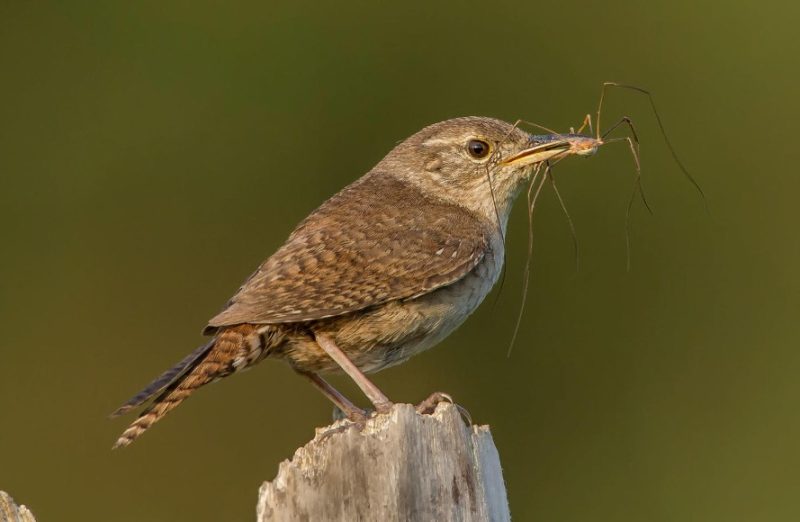
House Wrens, winter residents in Florida, are identified by their small, nondescript brown bodies with darker barred wings and tails, and a pale throat. Arriving in September and staying until July, they peak in visibility from October to early January.
These birds breed in the US and southern Canada during the summer, migrating to the southern US and Mexico for the winter. They frequent backyards, parks, and open woods, energetically hopping through foliage while foraging for insects and spiders, often with their tails held upright. Attract them with brush piles or nest boxes in your backyard.
American Robin
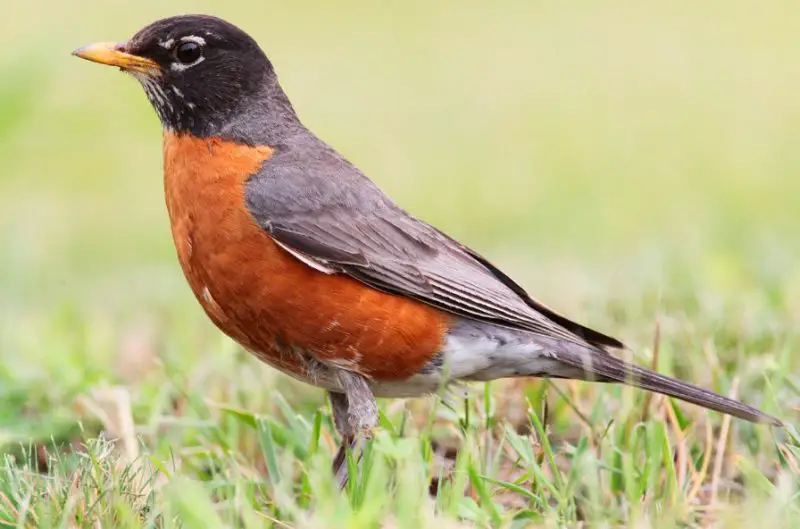
During winter in Florida, American Robins are frequently observed, appearing on 16% of checklists from November to mid-April. These birds are recognizable by their black heads and backs, which are complemented by red or orange breasts. They are often seen foraging for earthworms on lawns. Robins roost in trees during the winter, becoming more visible in backyards come spring.
Found year-round across the lower 48 states, western Canada, and Alaska’s coast, they migrate south from Canada and inland Alaska for winter. Attract them with sunflower seeds, suet, fruit, and mealworms on platform feeders or scattered on the ground, alongside berry-producing native plants like juniper and hawthorn.
House Finch
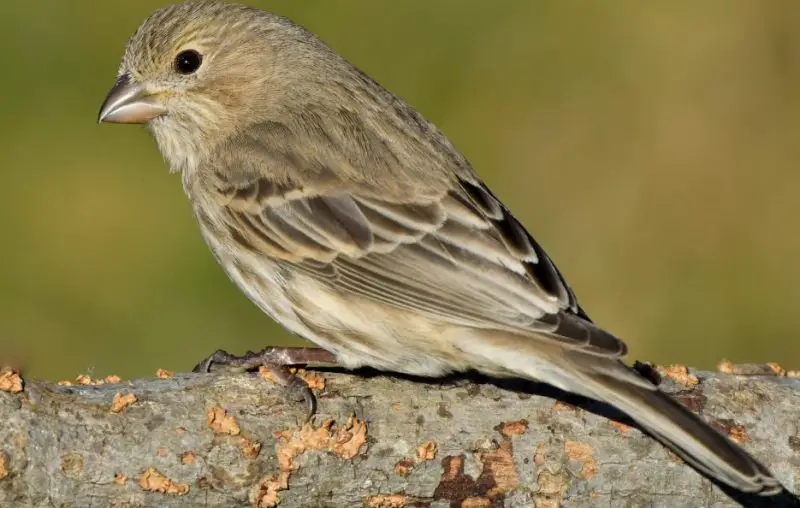
House Finches, introduced to residents in Florida year-round, are noted in 7% of summer and 4% of winter bird checklists. Females are brown-streaked, while males boast red heads and breasts with brown-streaked bodies. Originally from the western US, they were successfully introduced to the eastern states, thriving and even displacing Purple Finches.
Often seen in parks, farms, and forest edges, they gather noisily at backyard feeders. Attract them with black oil sunflower or Nyjer seeds in tube or platform feeders, noting their varied colors among Florida’s finch population.
House Sparrow
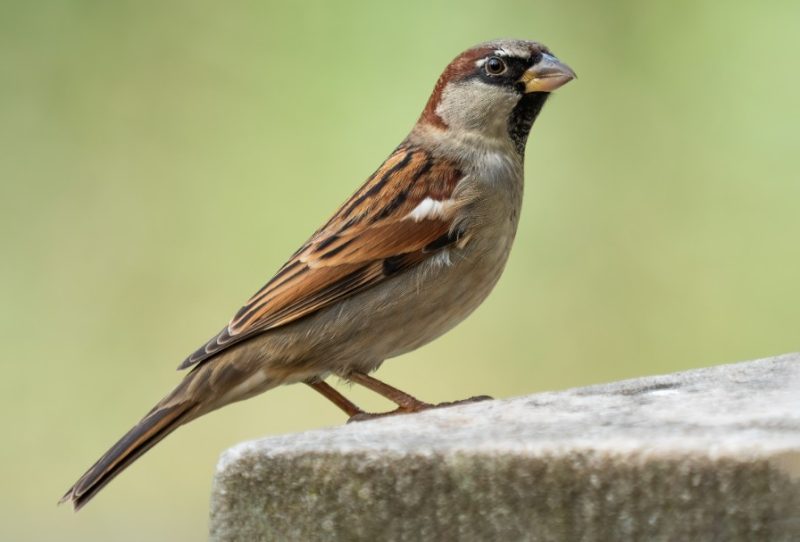
House Sparrows, introduced to residents in Florida throughout the year, are observed in 6% of summer and 3% of winter bird checklists. Recognizable by their gray and brown heads, white cheeks, black and brown backs, and gray bellies, they thrive near houses and buildings.
Originally from Europe and Asia, they have adapted well in the US and southern Canada, often becoming quite tame around human habitation. They are considered pests due to their non-native status and are commonly seen in urban and suburban areas. Attract them to backyard feeders with various birdseeds, including millet, corn, and sunflower seeds.
Northern Cardinal
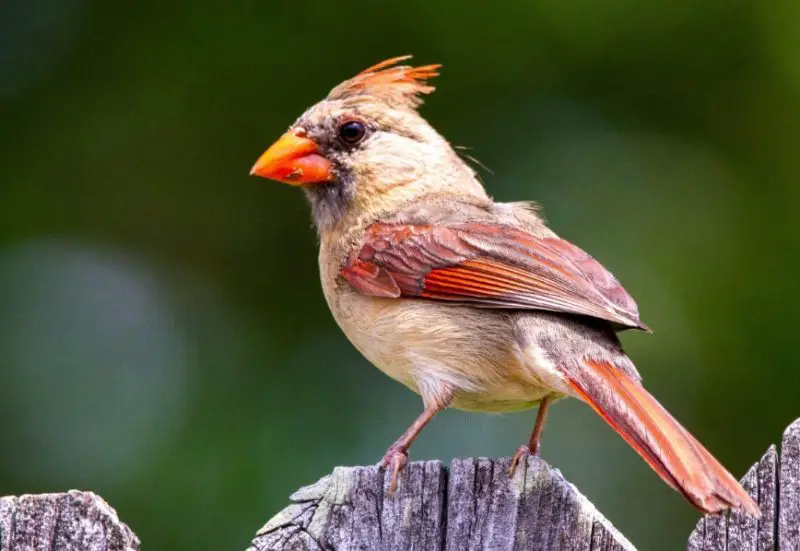
The female Northern Cardinal, commonly seen year-round in Florida, exhibits a more understated appearance compared to her vivid male counterpart. She sports a palette of browns, complemented by a sharp crest and subtle red accents on her wings and beak.
Unlike the striking red of the males, females blend in with their surroundings, often found in dense vegetation. Bird watchers report their presence on over half of summer checklists and nearly 40% of winter lists across the state.
Mourning Dove
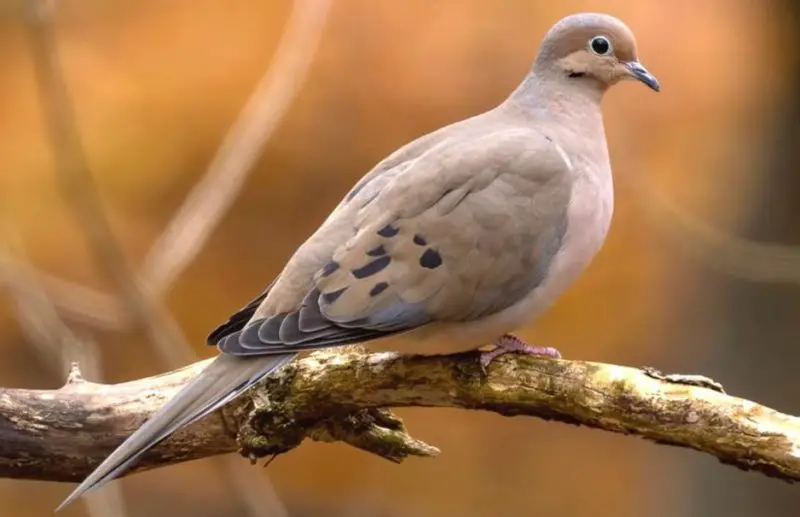
Mourning Doves are a familiar sight in Florida, present throughout the year but most commonly seen from February to October. Recognizable by their slender bodies, small heads, and long tails, they are soft brown with distinctive black wing spots. Typically, males are slightly larger than females.
Found across the contiguous United States year-round, they may migrate northward after breeding. Often perched on wires or foraging on the ground in grasslands and backyards, they are easily attracted to millet or seeds like sunflower and cracked corn on platform feeders or scattered on the ground.
Carolina Wren
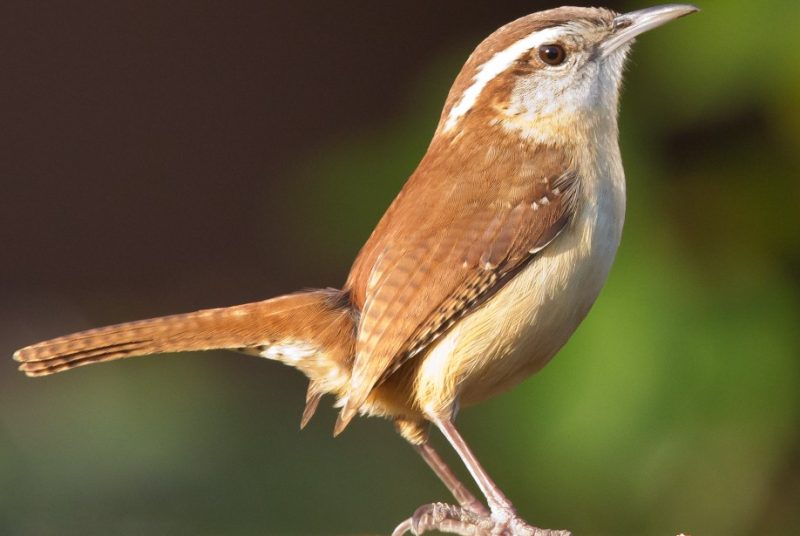
Carolina Wrens, non-migratory and prevalent year-round in Florida, are identified by their shy nature and distinctive coloring. They sport dark brown plumage above and lighter brown underneath, complemented by a prominent white eyebrow stripe and an upright tail. Their vocalization, often described as a loud ‘teakettle’ song, is a hallmark.
Found throughout the eastern and southeastern US, they inhabit wooded and densely vegetated areas, occasionally visiting backyard feeders for suet, hulled sunflower seeds, or peanut hearts. For more sightings, marshy habitats provide ideal spots.
American Goldfinch
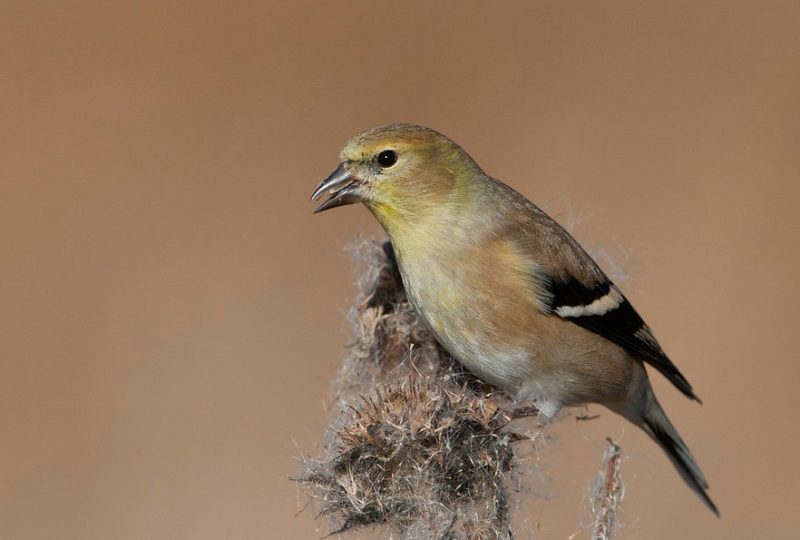
American Goldfinches, primarily winter visitors in Florida from November to April, appear on 8% of state winter checklists. Males sport bright yellow plumage with black accents in spring, while females and winter males are more subdued brown. They inhabit most of North America year-round, with Canadian and Midwestern breeders migrating south for the winter.
Often found in weedy fields, overgrown areas, suburbs, parks, and backyards, they forage on sunflower, thistle, and aster plants. Attract them with thistles, milkweed, and bird feeders stocked with sunflower and nyjer seeds.
Brown-headed Cowbird

Brown-headed Cowbirds are year-round residents in Florida, appearing in up to 4% of summer and winter checklists. Female Brown-headed Cowbirds are uniformly brown with slight streaking, while males are larger with black bodies, brown heads, and short tails.
These birds are found year-round in eastern and southern US states and along the Pacific Coast, with northern and western breeders migrating south for winter. Often seen as nuisances, they are brood parasites, laying eggs in the nests of smaller songbirds, which then raise their chicks.
Northern Flicker
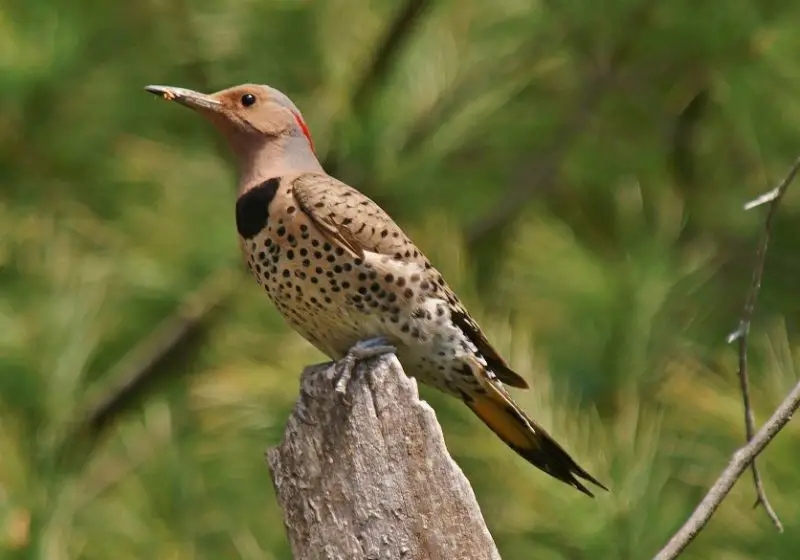
Northern Flickers, year-round residents in Florida, are noted in 2% of summer and 4% of winter checklists. These large brown woodpeckers have black spots and a white rump patch in flight, and males possess a red nape. They display red or yellow flashes in their wings and tails, with red-shafted flickers in the west and yellow-shafted flickers in the east.
Found across the US year-round and in Canada during summer, Canadian breeders migrate south for winter. They primarily eat ants, beetles, fruits, and seeds. They are often seen digging on the ground with their curved bills. Attract them to your backyard with suet, and you might also spot other woodpecker species in Florida.
Chipping Sparrow
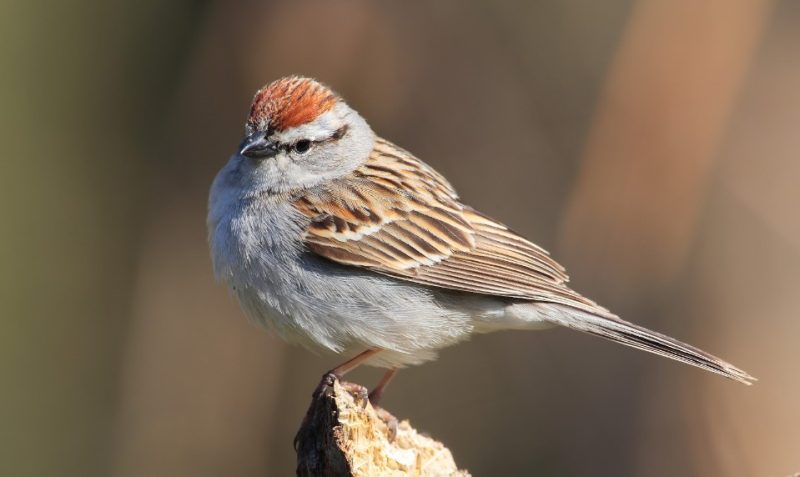
Chipping Sparrows are primarily winter visitors in Florida, appearing in 7% of winter checklists, especially from mid-October to April. These slender, long-tailed birds feature grayish bellies, brown and black-streaked backs, rusty crowns, and black eye lines, with more subdued colors in winter.
Breeding in the US and Canada during the summer, they migrate to Mexico and Florida for the winter, with some staying year-round in southern states. Found in small flocks on open ground, they visit backyards for various birdseeds. Attract them with seeds or cracked corn on hoppers or platform feeders.
Savannah Sparrow
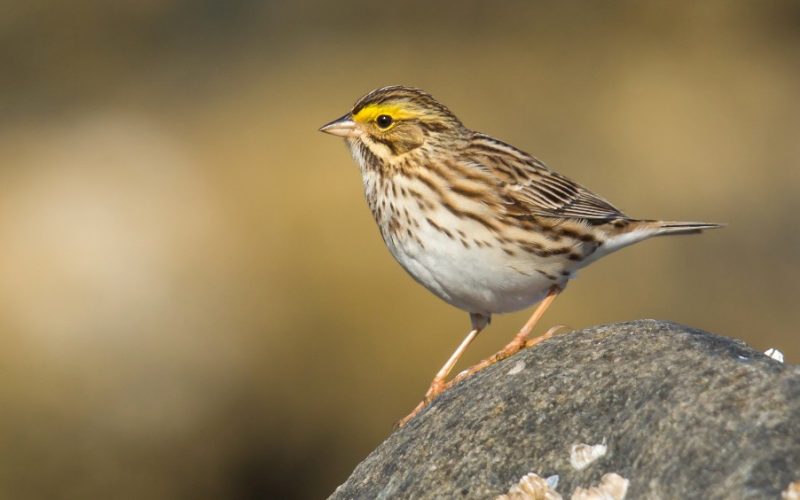
Savannah Sparrows, winter visitors in Florida, are observed from September to June, appearing in 6% of winter checklists. Identifiable by their brown, streaky coloring and distinctive yellow patch near the eye, these sparrows have short tails. They breed in Canada and the US, migrating to southern US states and Mexico for the winter.
Found in open areas like grasslands, they forage for insects and spiders during breeding and seeds in winter. They nest on or near the ground, laying up to six eggs. Though not regular feeder visitors, they may visit yards with brush piles, long grass, and nearby fields.
Cedar Waxwing
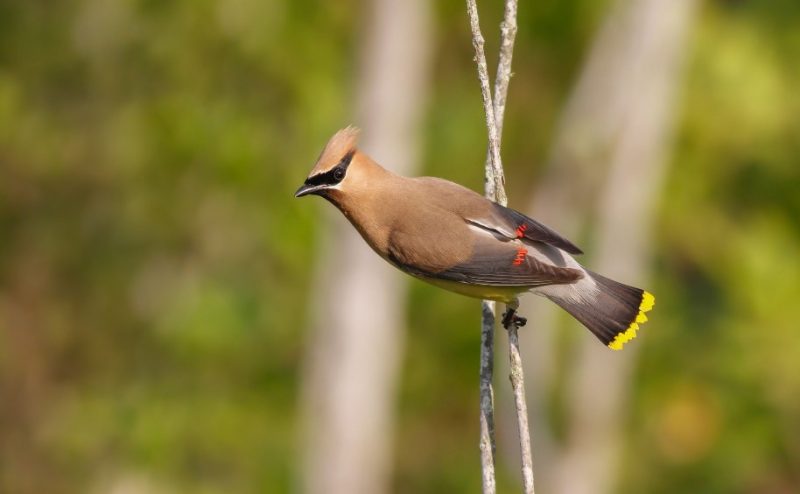
Cedar Waxwings are primarily seen in Florida during the winter, appearing on 4% of checklists from November to May. These elegant, social birds are pale brown on the head, chest, and crest, fading to gray on the back, wings, and tail, with a pale yellow belly. They feature a narrow black mask over their eyes and bright red wingtips.
Found year-round in the northern US, they migrate from Canada to the southern US for the winter. They inhabit berry bushes, woodlands, and streams, making high-pitched calls. Attract them by planting native fruit-bearing trees and shrubs like serviceberry, dogwood, juniper, winterberry, and hawthorn, or by offering fruit on platform feeders.
Swamp Sparrow
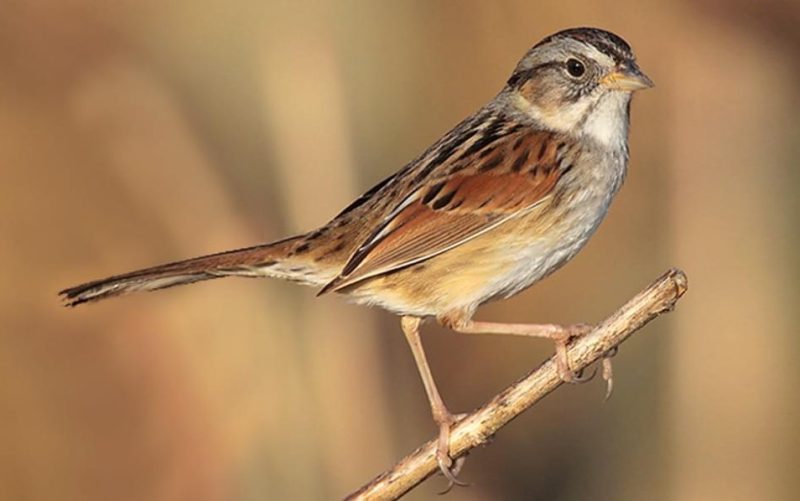
Swamp Sparrows appear on 5% of winter checklists in Florida, seen from September until May. These sparrows are dark brown on the back with rusty crowns and wings, gray breasts, white throats, gray heads, brown faces, and a dark eye line with a yellow-tipped beak. They breed in Canada and the northeastern and north-central US, migrating to the eastern and southern US and Mexico for the winter.
Found in wetlands, swamps, bogs, and coastal marshes, they feed on seeds and fruit in the winter and insects in the spring. Their nests are hidden in vegetation near the ground, made from twigs, leaves, and cattails. Swamp Sparrows rarely visit backyards, except those with dense vegetation and water.
Northern Waterthrush
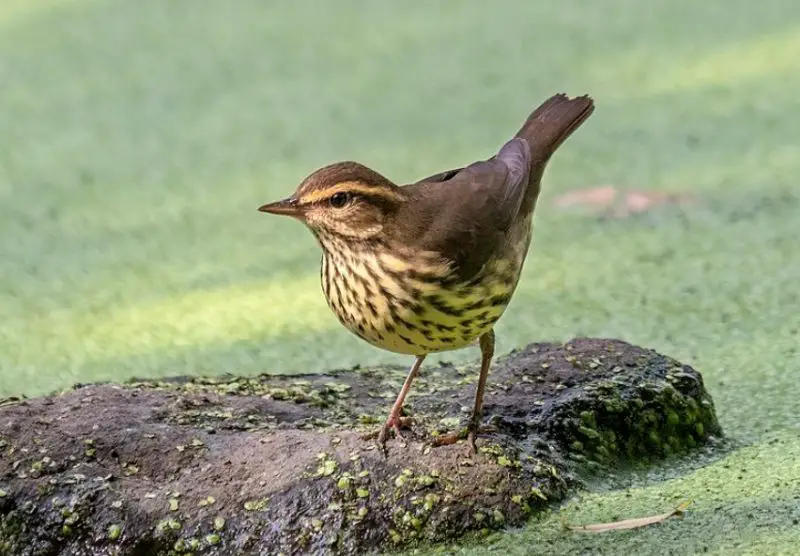
Northern Waterthrushes are spotted in Florida during the winter, with increased sightings during migration, recorded in 4% of spring and 7% of fall checklists. These large, thrush-like birds have brown heads with thick white eyebrows, dark brown backs, and white bellies with dark streaking. They breed in Canada, Alaska, and the northeastern US states before migrating to Mexico, Central and South America, and the Caribbean.
Found in dark, woody swamps, thickets, and bogs, they forage in shallow water for insects and small aquatic creatures. Their nests are hidden in hollows or crevices near water, often among ferns.
Marsh Wren
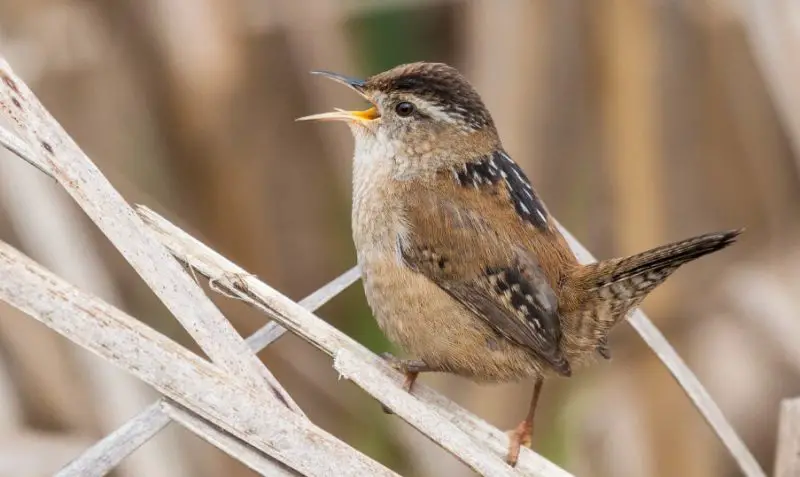
Marsh Wrens are most commonly seen in Florida during the winter, especially from October to December, appearing in 2% of checklists. These birds are brown with black and white streaks on their backs, grayish-brown undersides, and an upright tail. Males and females look the same. Marsh Wrens can be distinguished from Sedge Wrens by their lack of shoulder stripes and longer bills.
They breed in the northern US states and central Canada, migrating to the southern states and Mexico. In wetlands, they cling to reeds, eating insects and spiders. Their nests are fully enclosed, made from woven reeds and grasses, with a small opening at the top.
Hermit Thrush
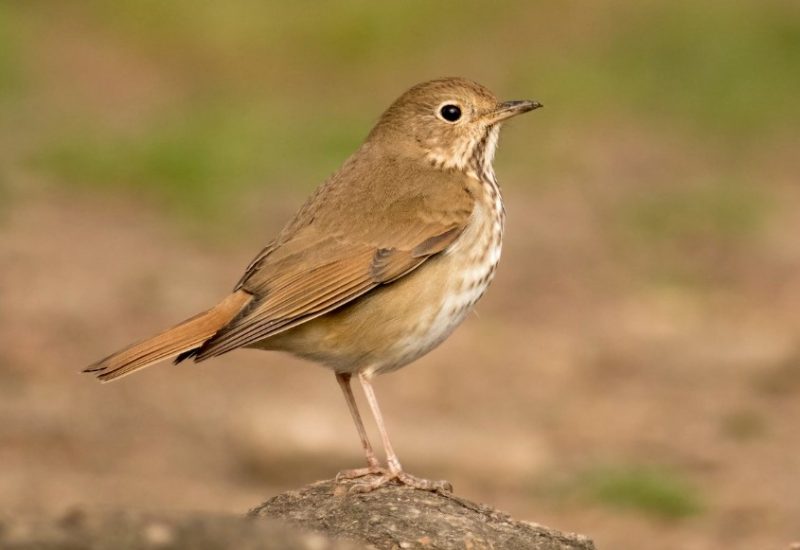
Hermit Thrushes spend the winter in Florida, occurring in 2% of checklists from October to April. These birds have an upright manner, chunky bodies, and long tails. They are brown on the back and white underneath, with spots on the throat and breast.
Hermit Thrushes breed in Canada, northeastern, and western US states, migrating through central states. They forage on the ground in forest clearings, eating insects and berries in the winter. Their forlorn song is heard in spring and summer.
Song Sparrow
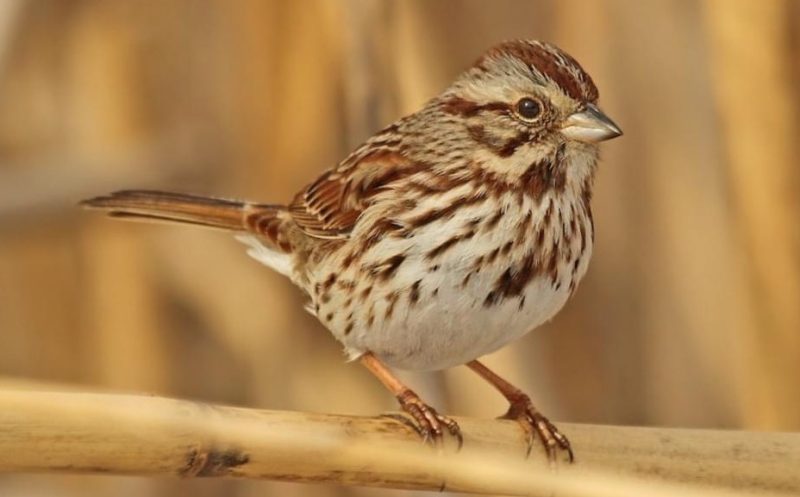
Song Sparrows are frequently spotted in Florida during the winter, appearing in 1% of checklists, most commonly from September to May. These brown-streaked birds are known for their constant song, used to attract mates in spring and summer.
They live year-round in northern US states, with those breeding in Canada migrating south for winter. Found in open, shrubby, and wet areas, they often perch on low shrubs. Attract them with black oil sunflower seeds, cracked corn, and Nyjer on platform feeders.
Swainson’s Thrush
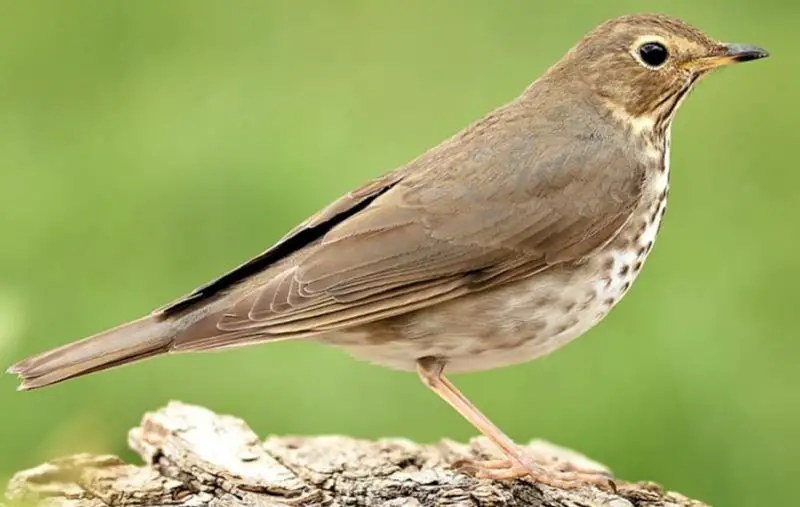
Swainson’s Thrushes are seen in Florida mainly from April to May and September to October, appearing in 3% of checklists in the spring and 9% in the fall. These medium-sized thrushes have pale undersides with spotted chests and brown backs.
They forage in forests, feeding on insects like ants and red fruits such as blackberries and raspberries during breeding season. Breeding in Canada and Alaska, they migrate through the lower 48 states to Central and South America for the winter. Attract them with ground-level birdbaths and tree cover in your backyard.
Purple Finch
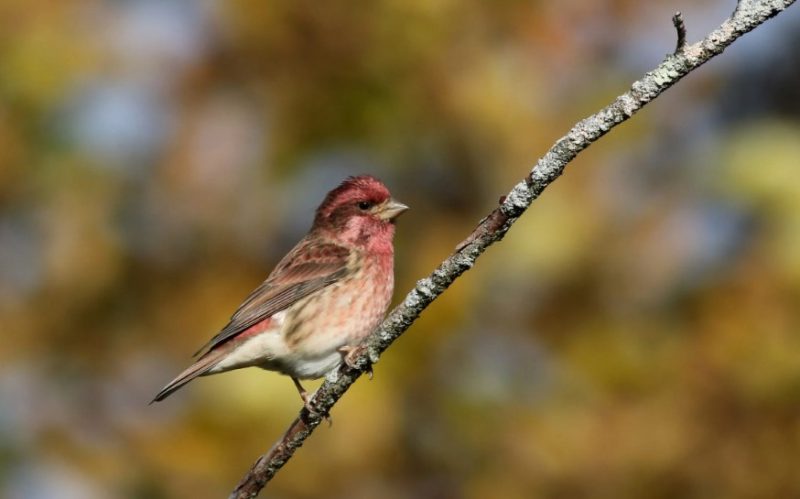
Purple Finches are common in northern Florida from October to mid-May during winter. Females are brown-streaked, while males have reddish-purple heads and breasts with brown wings and backs. They resemble House Finches but are redder on their upper backs. They breed in Canada, winter in the eastern US, and stay year-round in the northeast and Pacific coast.
Found in evergreen forests, they feed on seeds, buds, nectar, and berries. Their nests, high in trees, are made of twigs, bark, weeds, and moss, holding three to five eggs incubated by the female for about thirteen days. Attract them with black oil sunflower seeds.
Winter Wren
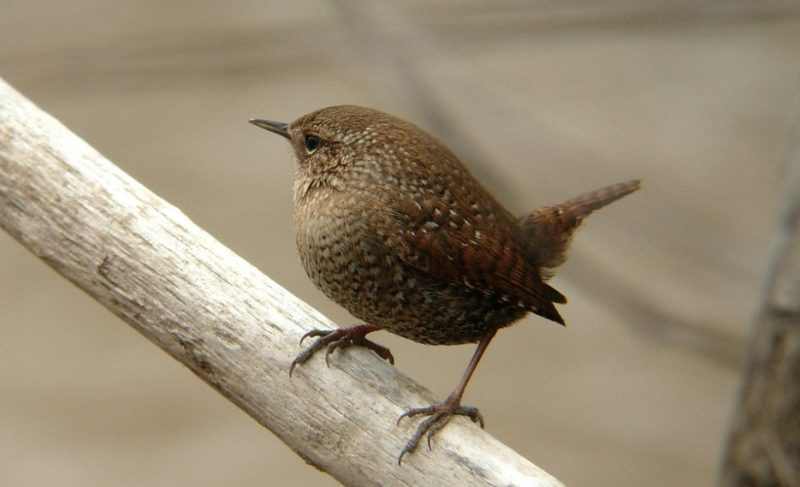
Winter Wrens are occasionally seen in northern Florida during the winter. They are small, plump brown birds with darker bars on their wings, tail, and belly. They sport a pale eyebrow stripe and keep their short tails upright. Both males and females look identical. Originally considered the same as Pacific Wrens, they are now recognized as distinct species with different songs.
Winter Wrens inhabit the eastern US in winter and breed in the northeastern US and Canada. Look for them in tangled forest undergrowth, where they feed on insects and spiders. Attract them with native plants and dense vegetation in your backyard.
Brown Creeper

Brown Creepers are usually seen in Florida from October to April, but they are uncommon. These tiny songbirds blend with tree trunks due to their streaked brown backs and white undersides.
Brown Creepers inhabit Alaska, southern Canada, and the northeastern US, extending to Mexico and Central America in winter. To spot them, look at mature woodland tree trunks, where they search for insects. Their high-pitched call aids in locating them.
Spotted Towhee
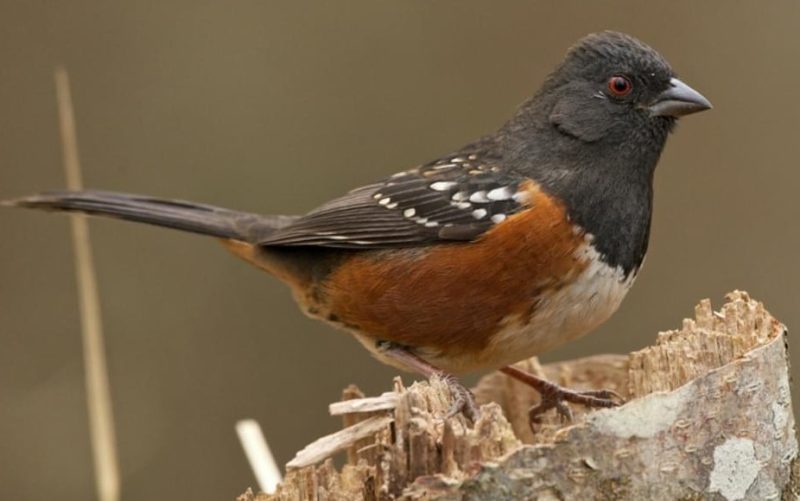
Spotted Towhees are rare in Florida but can occasionally be seen during migration. These large sparrows have black heads, throats, and backs in males and brown in females. Both have reddish-brown sides, white bellies, and white spots on their wings and backs.
Spotted Towhees live in western US states, migrating south after breeding. They forage on the ground for insects and seeds. Attract them with Black Oil Sunflower seeds, Cracked Corn, and Millet.
Golden-crowned Sparrow
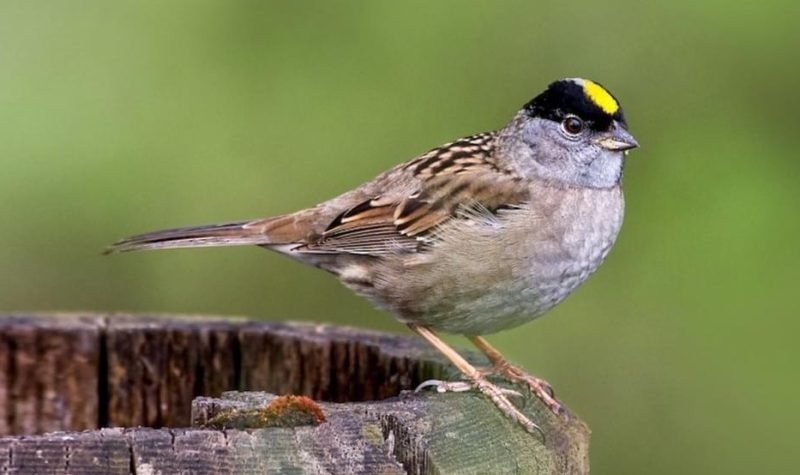
Golden-crowned Sparrows are rare in Florida but were spotted near Indian River Lagoon Preserve State Park in 2021. They are grayish-brown underneath with streaked brown backs, black crowns, and bright-yellow foreheads. Their colors dull in winter.
These sparrows breed in Alaska and western Canada, migrating to the West Coast for the winter. They forage in weedy fields for seeds and fruit, and they eat insects. Attract them with seeds on ground feeders or native fruiting plants.
Bewick’s Wren
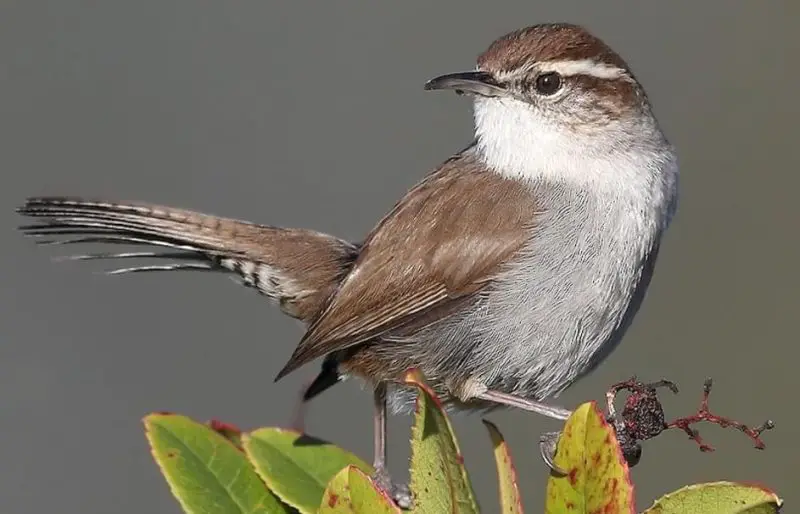
Bewick’s Wrens are considered accidental in Florida, last seen around the Gulf Islands National Seashore in 2013. These brown-backed birds have long gray tails with darker barring, gray bellies, and a white stripe over the eye. They live year-round in southern and western states.
Found in scrub and open woodland, they feed on insects and larvae. Attract them with suet, mealworms, and hulled sunflower seeds in your backyard.
Rose-breasted Grosbeak
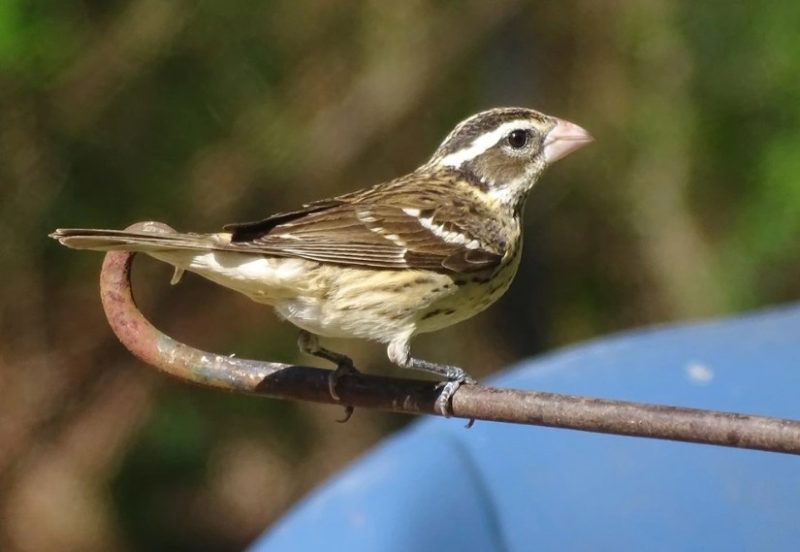
Rose-breasted Grosbeaks are typically seen in Florida during migration, especially in April and October, appearing in 5% of checklists at these times. Female and immature males are brown with streaks and a yellow wing flash. Males are black-and-white with black heads, white bellies, and red breasts, plus a red wing flash.
They breed in the northeastern US, Midwest, and Canada, migrating through the southeastern US. In winter, they’re found in Mexico, Central America, and the Caribbean. Look for them in forests, parks, and backyards, feeding on insects, berries, and seeds. Attract them with sunflower seeds and peanuts in your backyard.
White-throated Sparrow
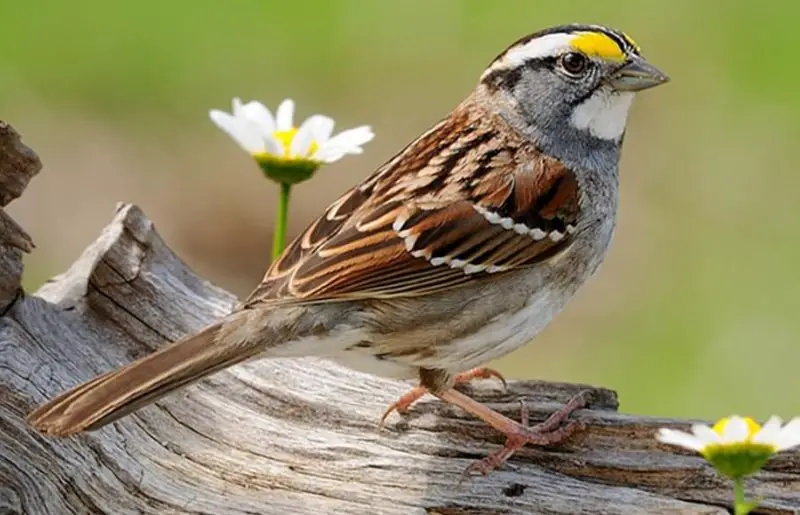
White-throated Sparrows are winter visitors in Florida, arriving as early as October and staying until July, with peak sightings from November to April. They have a striking black and white striped head, a bright white throat, and yellow patches near the eyes. Their backs are brown, and their undersides are gray.
These migratory sparrows breed in Canada and winter in the eastern and southern US, as well as on the Pacific Coast. They forage on the ground in forests and wooded edges, often in large flocks, feeding on seeds, fruits like grape and sumac, and insects from the forest floor. Attract them to your backyard with millet and black-oil sunflower seeds on platform feeders.
Louisiana Waterthrush
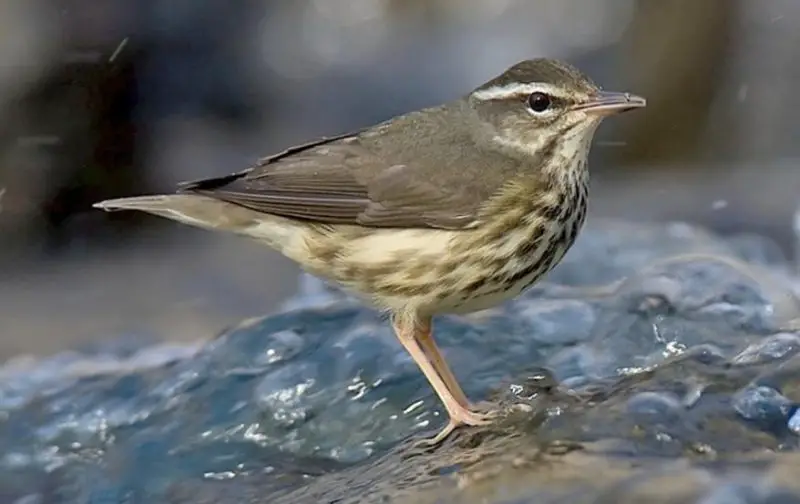
Louisiana Waterthrushes are predominantly seen in Florida during migration, particularly from March to April and July to September. They have a plain appearance compared to other warblers, with brown upperparts and pale underparts, highlighted by a distinctive white eyebrow stripe and long pink legs.
These birds breed in eastern US states and are found in the southeast during migration. They spend winters in Mexico, Central America, and the Caribbean, returning to breed early in the year. Look for them along streams and moving water in woodlands, where they hunt insects, vertebrates, and larvae. Their nests, located along stream banks, are typically concealed among roots or under logs, constructed from leaves, pine needles, and mud.
Wood Thrush
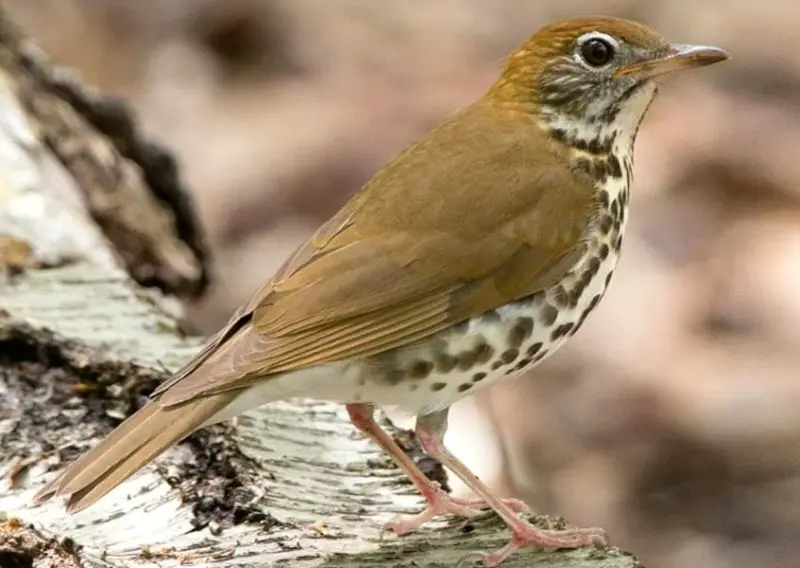
Wood Thrushes are typically seen in Florida during migration in April and October, with some occasional year-round sightings. They are known for their plump bodies with white bellies speckled with black spots, giving them a slightly whimsical appearance. Their backs are brown, adorned with reddish tones on the crown and upper back.
Wood Thrushes migrate swiftly from eastern US states across the Gulf of Mexico into Central America in a single night. These birds are elusive, often foraging in leaf litter for insects like beetles and flies within mature forests. Their springtime presence is marked by a distinctive, flute-like song.
White-crowned Sparrow
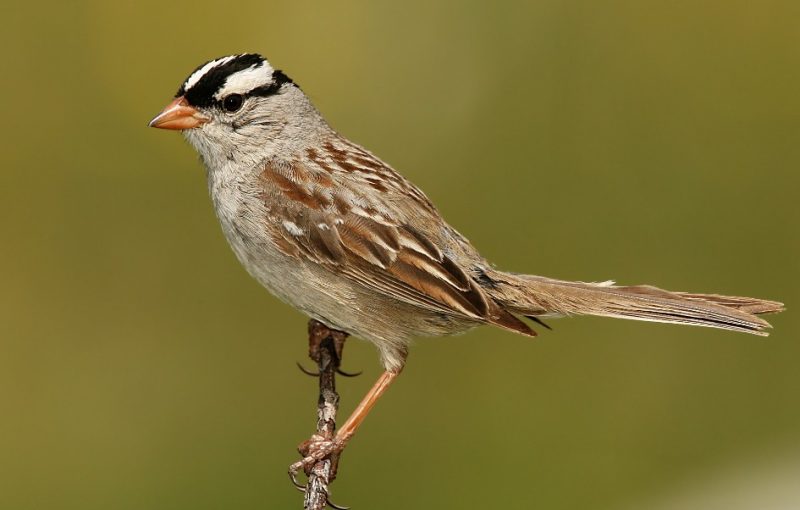
White-crowned Sparrows, seen sporadically in Florida from September to July (with peak sightings from November to March), are large sparrows with gray plumage, long tails, and distinctive black-and-white striped heads. They breed in Alaska and Canada’s arctic regions, migrating south to the lower 48 states and Mexico for the winter.
They forage in weedy fields, forest edges, and yards, feeding on seeds and fruits like elderberries. Nests are made low in shrubs or on the ground, consisting of twigs, grass, moss, and pine needles, where they lay up to seven eggs.
Pine Siskin
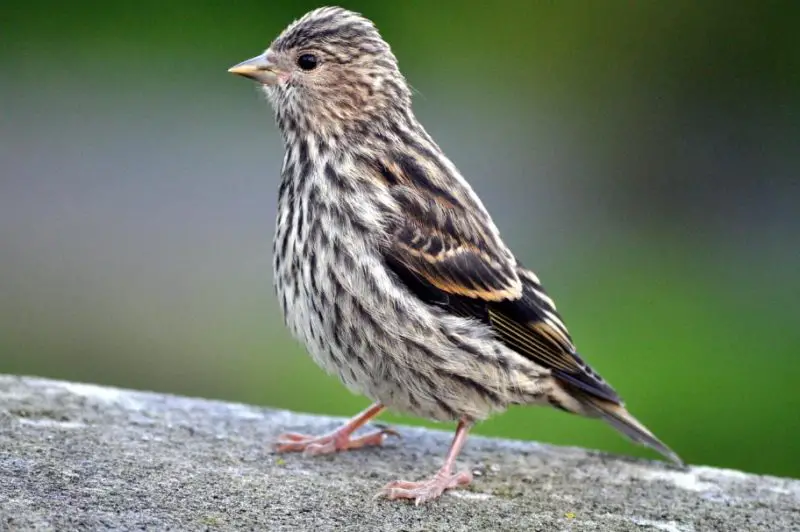
Pine Siskins are winter visitors to Florida, arriving in October and often staying until May, with peak sightings from February to April. These small brown finches sport yellow streaks on their wings and tails, with a forked tail, pointed wings, and a short, pointed bill.
They reside year-round in pine forests across western states and along the Canadian border, also breeding in Canada before migrating south. Pine Siskins primarily feed on conifer seeds but also consume young buds and seeds from grasses and weeds. Attract them with thistle, nyjer, black oil sunflower seeds, and suet in your backyard feeders.
Field Sparrow

Field Sparrows are year-round residents in Florida, with higher sightings during the winter from November to March. These small, slender birds have brown backs streaked with black and gray undersides and heads, highlighted by a reddish crown and pink bill.
Found primarily in eastern US states year-round, those breeding in the Midwest migrate south for winter. Field Sparrows are often heard singing from perches during the breeding season but feed quietly on weeds and seeds in abandoned fields.
They build nests on the ground initially, later moving higher, using grass, and laying up to five eggs. Attract them with cracked corn, hulled sunflower seeds, and millet in backyard feeders.

